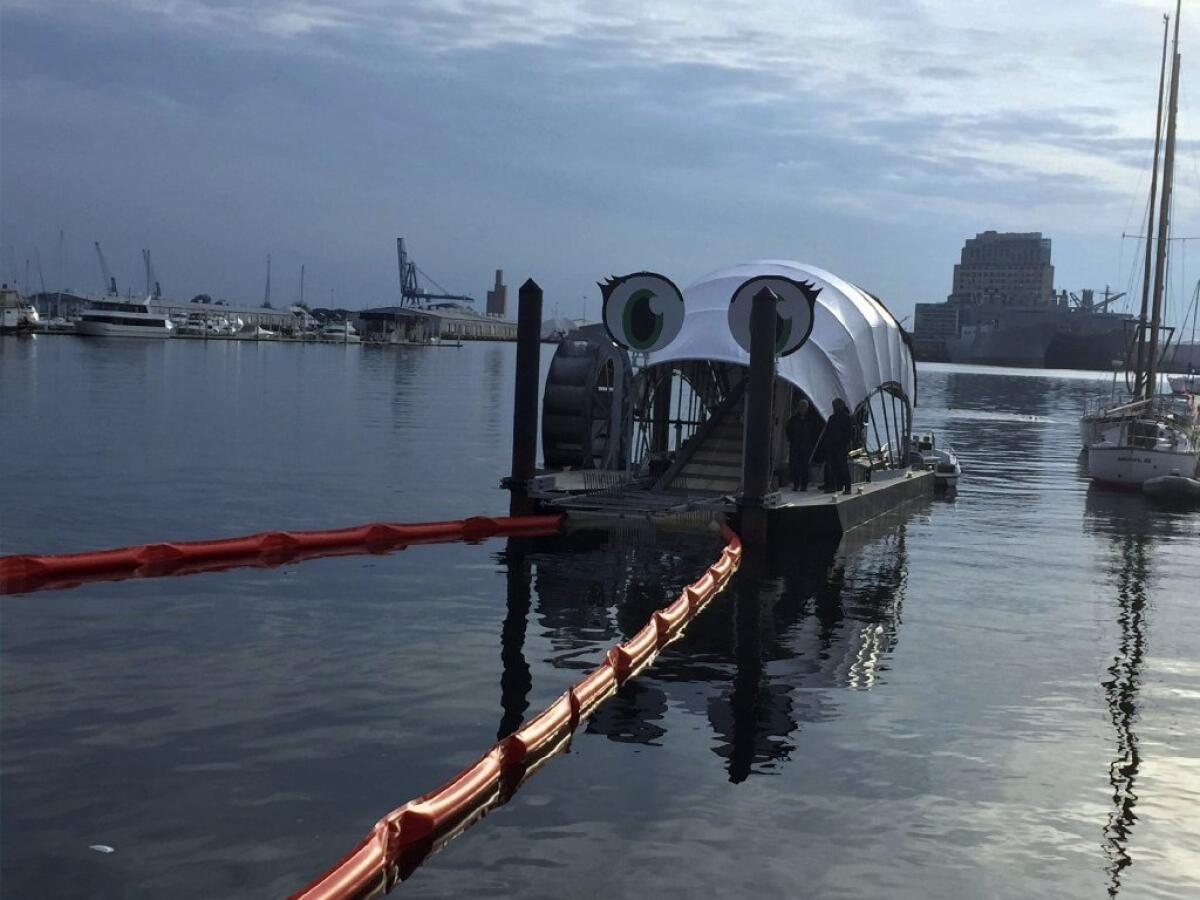Trash-snaring vessel to clean Newport Beach waters gains Coastal Commission approval

Newport Beach is drifting closer to operating a solar-powered, trash-snaring vessel known as a water wheel to clean up its bay, following recent approval from the California Coastal Commission.
The water wheel is expected to look like a snail with a paddle wheel or a conch shell crossed with a steamboat, mirroring its cousins in Baltimore’s Inner Harbor, where the first of two was installed in 2014.
As proposed, two booms would span the width of San Diego Creek and funnel trash toward the stationary barge, which would be mounted with a 17-foot-tall water wheel. Any debris would land on a conveyer belt, then travel into two dumpsters mounted on a fixed rail system. The dumpsters would be conveyed to land, where a garbage truck would access them and dispose of the trash.
Discussions to place the device in San Diego Creek date back to 2017, when estimates for the project ranged from $750,000 to $1 million. City spokesman John Pope said Monday the current cost estimate for the barge is not yet confirmed, as the drawings have not been finalized.
The city has about $2.2 million available in grants between the Ocean Protection Council and the Orange County Transportation Authority’s Measure M, according to city staff.
San Diego Creek, according to a staff report for the Coastal Commission, “introduces hundreds of tons of trash from surrounding urban development into downstream waterways each year.”
Newport Beach assistant city engineer Bob Stein agrees.
“San Diego Creek provides 80% of the fresh water to Newport Bay and probably 80% of the trash,” Stein said during his presentation to the commission.
Stein said that while the most obvious benefit of the project is that the unique vessel would be collecting trash, it could also stand as an icon to promote trash reduction regionally.
Through the use of the water wheel, the city would also be able to quantify the kinds of trash flowing into the bay, which could help provide data for possible future ordinances.
Coastal Commission staff noted in their report that while the barge will be an “effective” method of trash capture, it would not resolve the issue at its source. The city could further reduce the amount of trash entering community waterways by restricting single-use plastics and Styrofoam products in Newport Beach, the staff report said.
Commissioners agreed, saying city officials should consider the implementation of a single-use plastics ban, but they did not require it as one of their conditions for approval.
Hoiyin Ip, a member of the Sierra Club and co-chair of its California Zero Waste Committee, expressed her desire for such a requirement during public comments, asking the commission to require the city to adopt bans on smoking, the sale of tobacco, single-use plastics and balloons before granting the permit.
Dana Point resident and member of city’s ocean water quality subcommittee Bill Lane argued that once Newport Beach implemented the trash interceptor, then Dana Point would likely do the same “... to capture the plastics we should not have produced in the first place ... We feel Newport Beach with all its ability and influence should show proof of action on plastic reduction from the source before the interceptor permit is awarded. If others are encouraged to follow Newport’s example, we will continue to treat the symptom and not the disease.”
Stein told commissioners the water wheel will help provide “hard evidence” that can be presented not only to Newport Beach officials but to other cities in the region to convince them to institute ordinances that will reduce trash before it gets to the waterways.
The city still must acquire permits and approvals from other agencies such as the state Water Resources Control Board, U.S. Army Corps of Engineers, U.S. Fish and Wildlife, the Orange County Flood Control District and the Irvine Co., which owns the property, but groundbreaking could start as early as 2023.
Construction is expected to take at least a year, taking into consideration nesting season of bird species in the surrounding area.
All the latest on Orange County from Orange County.
Get our free TimesOC newsletter.
You may occasionally receive promotional content from the Daily Pilot.




